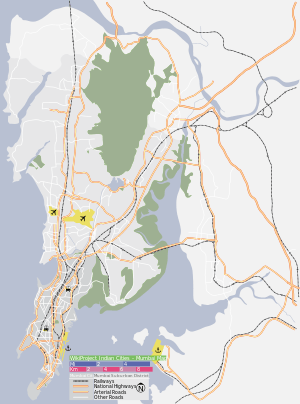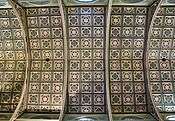Dr. Bhau Daji Lad Museum
|
| |
 Location within Mumbai | |
| Established | May 2, 1872 |
|---|---|
| Location | Veer Mata Jijabai Bhonsle Udyan, Dr. Baba Saheb Ambedkar Marg, Byculla East, Mumbai, Maharashtra 400027. |
| Coordinates | 18°58′46″N 72°50′05″E / 18.979472°N 72.834806°E |
| Director | Tasneem Zakaria Mehta |
| Website | http://www.bdlmuseum.org/ |
The Dr. Bhau Daji Lad Mumbai City Museum (formerly the Victoria and Albert Museum) is the oldest museum in Mumbai. Situated in Byculla East, it was originally established in 1855 as a treasure house of the decorative and industrial arts,[1] and was later renamed in honour of Bhau Daji.
History
Lord Elphinstone established the Central Museum of Natural History, Economy, Geology, Industry and Arts, the first museum in Bombay in 1855; George Buist took the major initiative for its inception. In 1857, it was closed to the public and its collection was shifted to the Town Hall. In 1858, George Birdwood was appointed curator of the museum. Soon, a committee was formed, comprising him, Bhau Daji Lad and Jaganath Shunkerseth to raise money for construction of a new building for the museum. The foundation of the new building was laid in 1862. It was built with the patronage of many wealthy Indian businessmen and philanthropists like David Sassoon, Sir Jamsetjee Jejeebhoy and Jaganath Shunkerseth.
The construction of the present building in Jijamata Udyan in Byculla started in 1862 and was completed in 1871.[2] The museum was opened on May 2, 1872. In 1975, this museum was renamed as the Dr. Bhau Daji Lad Mumbai City Museum.
Between 2003 and 2007, this museum has undergone a major restoration under the supervision of the Mumbai chapter of the Indian National Trust for Art and Cultural Heritage (INTACH) and financed by the Jamnalal Bajaj Trust.[3]
Governance
The Museum is managed by a public-private partnership, a first for a cultural institution in India. The partnership involves the Municipal Corporation of Greater Mumbai, the Jamanlal Bajaj Foundation and the Indian National Trust for Art and Cultural Heritage (INTACH).[4]
Tasneem Zakaria Mehta is the Honorary Director of the Museum and has a Board of Management and Trustees that include the Mayor and the Municipal Commissioner of Mumbai.[5]
Collections

This museum houses a large number of archaeological finds, maps and historical photographs of Mumbai, clay models, silver and copper ware and costumes. Its significant collections include a 17th-century manuscript of Hatim Tai[6] Outside the museum is the istallation of the monolithic basalt elephant sculpture recovered from the sea, which originated from Elephanta Island (Gharapuri Island).
Gallery
| Dr. Bhai Daji Lad Museum | ||||||||
|---|---|---|---|---|---|---|---|---|
|
References
- ↑ Hoskote, Ranjit (September 7, 2005). "Honour for a treasure trove of art". The Hindu. Retrieved 2009-06-27.
- ↑ "PLACES". Maharashtra State Gazetteers-Greater Bombay District.
- ↑ "Bhau Daji Lad museum to be finally inaugurated". The Indian Express. January 2, 2008. Retrieved 2009-06-27.
- ↑ "Dr. Bhau Daji Lad Museum - The Tripatriate Agreement". Dr. Bhau Daji Lad Museum website. Retrieved 7 September 2011.
- ↑ "The Tripatriate Agreement". Dr. Bhau Daji Lad Museum official website. Retrieved 13 September 2011.
- ↑ Koppikar, Smruti (January 21, 2008). Passage to Bombay in Outlook, Vol.XLVIII, No.3, pp.61-3.
External links
| Wikimedia Commons has media related to Dr. Bhau Daji Lad Museum. |




